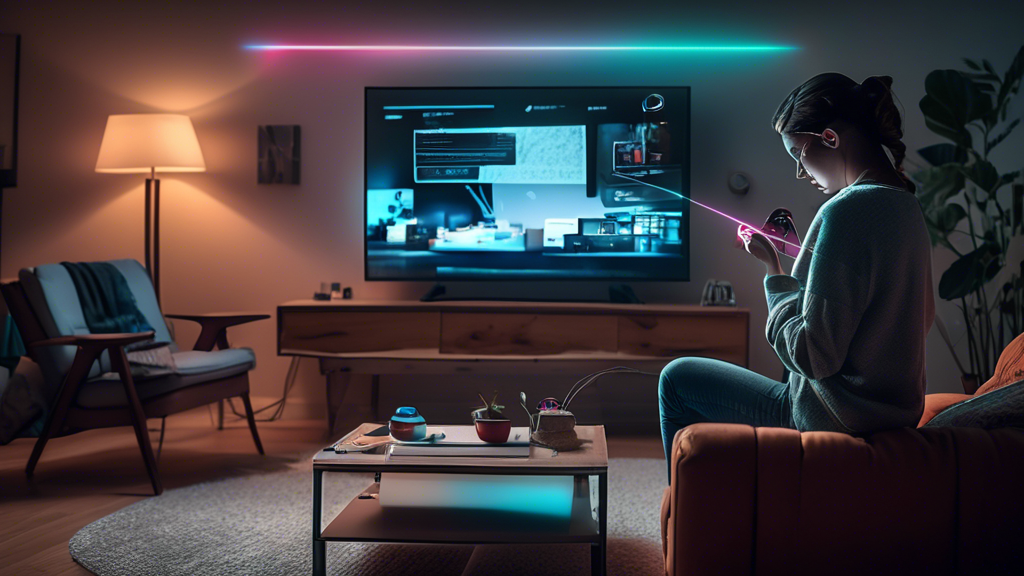Guide to Smart TV Antenna Setup
Are you ready to cut the cord and enjoy free, high-definition television using your Smart TV? A Smart TV antenna setup can provide you with access to a wide range of local channels without the need for costly cable subscriptions. But what exactly is a Smart TV antenna, and why is proper setup so important?
A Smart TV antenna is a device specially designed to pick up over-the-air (OTA) television signals, allowing you to watch local broadcast channels in stunning clarity. Whether you’re a fan of sports, news, or popular TV shows, using a Smart TV antenna offers numerous benefits. Not only does it save you money, but it also delivers uncompressed HD signals, ensuring a superior viewing experience.
Setting up your Smart TV antenna correctly is crucial to maximizing its performance. Proper installation can significantly enhance signal quality, reduce interference, and ensure you receive the most channels possible. Without the right setup, you might miss out on the free content available in your area, or suffer from poor signal reception that disrupts your viewing enjoyment.
In this comprehensive guide, we will walk you through the step-by-step process of setting up your Smart TV antenna. From gathering the necessary materials to fine-tuning your reception, we’ve got you covered. Additionally, we will provide solutions to common issues such as poor signal quality and interference, ensuring that your Smart TV antenna setup delivers consistent, high-quality performance.
Ready to unlock a world of free television? Let’s dive into the ultimate guide to Smart TV antenna setup and start enjoying all the benefits today!
Guide to Smart TV Antenna Setup
Introduction to Smart TV Antenna Setup
What is a Smart TV Antenna?
A Smart TV antenna is a device designed to receive over-the-air (OTA) broadcast signals, which are then displayed on a Smart TV. These antennas can receive signals from local television stations, allowing you to access free TV channels without the need for a cable or satellite subscription.
Key Features:
- Receives OTA broadcast signals.
- Compatible with Smart TVs.
- Offers access to free local channels.
Smart TV antennas come in various types, including indoor, outdoor, and amplified versions. Each type has its advantages depending on your location, signal strength, and the distance from broadcast towers.
Benefits of Using a Smart TV Antenna
Understanding the benefits of using a Smart TV antenna can help you make an informed decision:
- Cost Savings: One of the most significant advantages is the elimination of monthly cable or satellite fees. Once you purchase the antenna, there are no additional costs.
- Access to Local Channels: You gain access to local news, sports, and entertainment channels that may not be available through streaming services.
- High-Quality HD Reception: Many OTA signals are broadcast in high-definition, ensuring excellent picture and sound quality.
- Easy to Set Up: Most Smart TV antennas are straightforward to install, often requiring just a few simple steps to get started.
- Digital Content: Modern antennas are designed to receive digital signals, providing better performance and more channel options than older analog models.
For more information on the different types of Smart TV antennas and their benefits, you can visit Consumer Reports – TV Buying Guide.
Why Proper Setup is Crucial
Properly setting up your Smart TV antenna is essential for several reasons:
- Optimal Reception: Correct positioning and installation of your antenna ensure you receive the maximum number of channels with the best possible signal quality.
- Minimize Interruptions: Proper setup helps reduce issues such as pixelation, dropped signals, or complete signal loss, which can happen if the antenna is not correctly aligned or placed.
- Saves Time and Frustration: A well-installed antenna means less troubleshooting and adjustments later on, saving you time and avoiding frustration.
- Enhanced Viewing Experience: Consistent and clear reception contributes to a better viewing experience, making your investment in a Smart TV antenna worthwhile.
Failing to set up your Smart TV antenna correctly can lead to:
| Problems | Consequences |
|---|---|
| Poor Signal Quality | Choppy or pixelated video, interrupted audio |
| Signal Dropouts | Loss of channels, frequent video freezing |
| Incomplete Channel Scan | Missing out on available local channels |
By taking the time to correctly set up your Smart TV antenna, you can significantly enhance your viewing experience and enjoy a wide range of free, high-quality television content. This foundational step ensures that you get the most out of your Smart TV’s capabilities while maximizing the performance of your antenna.
For a detailed tutorial on setting up a Smart TV antenna, you can explore this helpful CNET Guide on HDTV Antenna Setup.

Step-by-Step Guide to Setting Up Your Smart TV Antenna
Materials You Will Need for Smart TV Antenna Setup
Before you dive into the actual smart TV antenna setup, it’s essential to gather all the necessary materials. Here’s what you will need:
- 🌐 Smart TV Antenna
- 🔌 Coaxial Cable
- 📄 Antenna Mounting Kit (if needed)
- 🛠️ Tools: Screwdriver, Drill (optional), and Screws (if mounting)
Finding the Optimal Location for Your Antenna
The placement of your antenna is one of the most critical factors in ensuring you get the best signal. Here are several tips to find the optimal location:
- 📶 High Elevation: Placement higher up, like in an attic or mounted on a wall, generally provides better reception.
- 🌲 Avoid Obstructions: Ensure the antenna is far from tall buildings, trees, and other large physical barriers that could obstruct the signal.
- 🏠 Outdoor vs. Indoor: Outdoor antennas typically provide better reception but are exposed to weather elements. Indoor antennas are easier to install but might offer weaker reception.
- 🧭 Direction: Point your antenna in the direction of your local broadcast towers. Use resources like DTV Maps by the FCC to find tower locations near you.
Connecting the Antenna to Your Smart TV
After determining the optimal location for your antenna, the next step is to connect it to your Smart TV. Here’s how:
- 🔌 Connect the Coaxial Cable: Attach one end of the coaxial cable to the antenna and the other end to the “Antenna In” or “RF In” port on your Smart TV.
- 📺 Power Up: Plug in your Smart TV and power it on.
- 🛠️ Secure Antenna Placement: If you are using a mounting kit, secure the antenna in your chosen location using screws and a drill if needed.
Running a Channel Scan and Fine-Tuning Reception
Once your antenna is connected, you need to run a channel scan to detect available channels and fine-tune your reception. Follow these steps:
- 📋 Access TV Menu: Use your remote control to navigate to the settings menu on your Smart TV.
- 🔍 Channel Scan: Locate the “Channel Setup” or “Broadcast” option in the menu, and select “Auto Channel Scan” or similar.
- 📡 Scanning Process: Allow your TV to scan for all available channels. This process may take a few minutes.
- 📶 Fine-Tuning: After the scan is complete, review the channels available. If some channels have poor reception, adjust the antenna’s direction slightly and re-scan.
With these steps, you should be able to complete your smart TV antenna setup efficiently. Enjoy a plethora of over-the-air channels with enhanced picture quality!
For more in-depth guides, tips, and product reviews, visit Digital Trends – Best TV Antennas.

Troubleshooting Common Issues in Smart TV Antenna Setup
Even with the best preparation, you may encounter issues while setting up your smart TV antenna. Knowing how to tackle these problems can save you time and enhance your viewing experience. Below, we discuss common issues and how to address them effectively.
Poor Signal Quality and How to Improve It
Signal quality is a common concern in smart TV antenna setup. Here are some factors to consider and steps to enhance signal quality:
| Issue | Solution |
|---|---|
| Low Signal Strength |
|
| Weak Channel Reception |
|
| Intermittent Signal |
|
Dealing with Interference and Obstructions
Interference and obstructions can majorly affect your smart TV antenna setup. Here’s how to manage them:
- 🌲 Trees and Buildings:
- 🌳 Trim tree branches that might be blocking your antenna’s line of sight.
- 🏢 Position the antenna as far from large buildings as possible.
- 🔧 Household Electronics:
- 🌐 Devices such as Wi-Fi routers, microwaves, and other electronics can cause interference. Relocate these devices away from your antenna.
- 🗺️ Electromagnetic Interference:
- 📡 Avoid placing the antenna near thick walls, metal objects, or any utilities that might emit electromagnetic waves.
Regular Maintenance Tips for Consistent Performance
Regular maintenance can help ensure consistent performance of your smart TV antenna setup. Here’s how to keep everything in top shape:
- 📅 Scheduled Checks: Perform regular checks, at least once a month, to ensure all components are functioning correctly.
- ⚙️ Inspect for Wear and Tear:
- 🔄 Rotate or slightly adjust the antenna if you notice any changes in signal quality.
- 🔌 Check for frayed or old cables and replace them as needed.
- 🧹 Cleaning:
- 🌌 Dust can build up on your antenna and affect its performance. Clean the antenna surface periodically.
- 🔄 Software Updates:
- 🌐 Ensure your smart TV’s firmware and software are up-to-date to avoid compatibility issues.
By tackling these common issues and performing regular maintenance, you can get the most out of your smart TV antenna setup. For more tips and troubleshooting advice, consider checking out additional resources such as professional forums and official user guides from antenna manufacturers.
In conclusion, setting up a Smart TV antenna can greatly enhance your TV-watching experience, providing you with high-quality, free over-the-air channels. It is important to understand what a Smart TV antenna is and recognize its benefits, such as access to local broadcasts and the potential for better picture quality without the hefty fees associated with cable services. A proper setup is crucial to maximize these benefits and ensure a seamless viewing experience.
Following a step-by-step guide can simplify the setup process. Gathering all necessary materials beforehand, finding the best location for the antenna, securely connecting it to your Smart TV, and running a channel scan for optimal reception are essential steps. Fine-tuning the reception after the initial setup can further improve the signal quality and the number of channels available to you.
However, it’s not uncommon to encounter issues during the setup. Poor signal quality can often be ameliorated by repositioning the antenna or using additional signal boosters. Interference and obstructions such as buildings or weather conditions can affect reception, so being mindful of your antenna placement and making adjustments as needed can help mitigate these problems. Regular maintenance, such as checking connections and ensuring the antenna is free of damage or obstructions, will ensure consistent performance.
By following these guidelines, you can enjoy a variety of programming with improved clarity and reliability. For more detailed information on troubleshooting and optimizing your Smart TV antenna setup, consult your antenna’s user manual or visit [external website] for additional resources.
